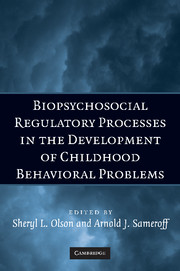Book contents
- Frontmatter
- Contents
- Preface
- Contributors
- 1 Conceptual Issues in Studying the Development of Self-Regulation
- 2 How Gene-Environment Interactions Can Influence the Development of Emotion Regulation in Rhesus Monkeys
- 3 Context Matters: Exploring Definitions of a Poorly Modulated Stress Response
- 4 An Integrative Approach to the Neurophysiology of Emotion Regulation: The Case of Social Withdrawal
- 5 Regulatory Competence and Early Disruptive Behavior Problems: The Role of Physiological Regulation
- 6 Behavior Regulation as a Product of Temperament and Environment
- 7 Self-Regulatory Processes in the Development of Disruptive Behavior Problems: The Preschool-to-School Transition
- 8 Emotional Dysregulation and the Development of Serious Misconduct
- 9 Regulatory Processes in Children's Coping with Exposure to Marital Conflict
- 10 Family Subsystems and Children's Self-Regulation
- 11 Culture and the Development of Regulatory Competence: Chinese–U.S. Comparisons
- 12 Self-Regulation and the Development of Behavioral and Emotional Problems: Toward an Integrative Conceptual and Translational Research Agenda
- Index
Preface
Published online by Cambridge University Press: 02 July 2009
- Frontmatter
- Contents
- Preface
- Contributors
- 1 Conceptual Issues in Studying the Development of Self-Regulation
- 2 How Gene-Environment Interactions Can Influence the Development of Emotion Regulation in Rhesus Monkeys
- 3 Context Matters: Exploring Definitions of a Poorly Modulated Stress Response
- 4 An Integrative Approach to the Neurophysiology of Emotion Regulation: The Case of Social Withdrawal
- 5 Regulatory Competence and Early Disruptive Behavior Problems: The Role of Physiological Regulation
- 6 Behavior Regulation as a Product of Temperament and Environment
- 7 Self-Regulatory Processes in the Development of Disruptive Behavior Problems: The Preschool-to-School Transition
- 8 Emotional Dysregulation and the Development of Serious Misconduct
- 9 Regulatory Processes in Children's Coping with Exposure to Marital Conflict
- 10 Family Subsystems and Children's Self-Regulation
- 11 Culture and the Development of Regulatory Competence: Chinese–U.S. Comparisons
- 12 Self-Regulation and the Development of Behavioral and Emotional Problems: Toward an Integrative Conceptual and Translational Research Agenda
- Index
Summary
The theme of regulatory disturbances in development is an exciting and timely topic. In recent years, there has been an explosion of research on regulatory processes governing the development and expression of child psychopathology. A diverse range of biological, behavioral, and social-ecological processes have been shown to play integral roles in the development of childhood behavior disorders. Conceptualizing the nature of these influences and “capturing” them in research paradigms remain strong challenges for developmental scientists. For example, when we refer to a child's functioning as dysregulated, we could be describing atypical patterns of psychophysiological responding, extreme fluctuations of activity or attention, loss of control over behavioral impulses, or variations in the expression, intensity, duration, or patterning of emotional responding. Moreover, without knowing the specific developmental or social contexts of the child's behavior, we cannot assign meaning to any of the pieces of this puzzle. Current theoretical models of psychopathology and self-regulation underscore the importance of developing research paradigms that synthesize biological, behavioral, and social influences. However, most prior research on the regulatory bases of child behavior disorders has been domain-specific. Thus, our first goal was to provide a series of “state of the art” chapters presenting a full spectrum of regulatory processes. In this spirit, each of our contributing authors has examined interactions among regulatory influences that range from genes to cultural factors.
- Type
- Chapter
- Information
- Biopsychosocial Regulatory Processes in the Development of Childhood Behavioral Problems , pp. vii - xPublisher: Cambridge University PressPrint publication year: 2009
- 1
- Cited by



